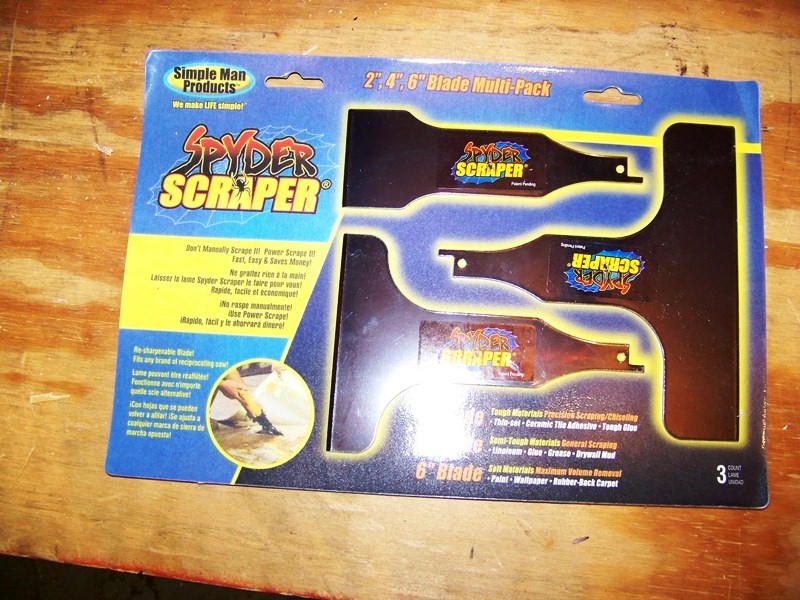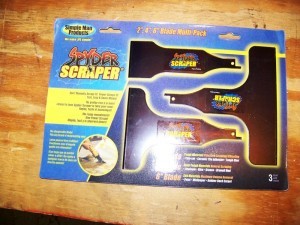Having the right tool for the job makes a world of difference. Not only does it make the job easier and save time, but it can also save your body from damage such as your knees or back. Sometimes there is a product so simple and is effective in all the above, you just have to kick yourself in the butt and think, why didn’t I think of that. Well I didn’t, but Spyder did, it’s called the Spyder Scraper.
The Spyder scraper is a straight edge that attaches to any reciprocating saw and allows the user to complete tasks much quicker using the power of the saw as opposed to doing it a manual way. The scraper comes in three different sizes 2”, 4”, 6”.
Below is a list of items each scraper would work good for:
2” Spyder Scraper
- Ceramic tile
- Thin-Set
- Vinyl Composition Tile
- Tough Glue
- Linoleum
- Drywall Mud
- Paint
4” Spyder Scraper
- Tough Glue
- Linoleum
- Drywall Mud
- Paint
- Rubber-back Carpet
6” Spyder Scraper
- Drywall Mud
- Paint
- Rubber-back Carpet
- Wallpaper
We did find it much better to use a reciprocating saw that has a variable speed setting. While a variable speed trigger will work just fine, there were times where we found it hard to stay at a consistent speed with the trigger approach.
We took these for a test run when we were replacing some Ceramic tile in a kitchen. Now I am not sure about using it for a whole floor as there are faster ways to remove tile, but for the little area we needed to replace, it did a great job. We were able to have complete control and not break any tile around the area we didn’t want to damage. We were able to remove only the tile we needed. We really wanted to use the 6” scraper on some rubber-back carpet, but there were no jobs going on that we could test it on. I don’t think my wife would be too happy with us using it on the basement carpeting.
Conclusion
If you’re looking for a handy little tool that can save time and make life a little easier, the Spyder scraper is worth a shot. We like how it can be attached to any reciprocating saw and the blades can be sharpened. It makes a quick job out of a tedious task.
We always like to hear back from our readers on their experience with these tools – good or bad. Do you have experience with these tools? How has the long term use been? What applications have you used the tool for? Is this a DIY or professional grade tool? Let us and other readers know.




Im glad your scrapers worked well. I didnt have the same results. I wanted to remove some 50 year old lanolium floor covering. I had allready removed the lanolium all that is left is the backing. Its on a concrete slab. I have taken a utility knive and cut long strips about an inch or two apart all the way across the floor then saturated the backing with adhesive remover. After several saturations of adhesive remover i grabbed my ryobi saws all with a brand new two inch blade. It was like trying to move lead with a cooked spaghetti noodle. I tried every speed from barely moving to full on nitro. All the thing did is ship around bounce and i think i did see it nick a spot of the backing before bouncing away. The shafts are way too weak in my opinion. Perhaps if the scraping part was at a 90 degree angle to the shaft part of the balde it would give enough strength to the tool to do some good. Or just make the shaft metal thicker. Im thinking about taking some metal and attaching it to the scraper shaft to beef up its strength and eliminate the flexibility of the shaft. I grabbed a paint scraper with a dull blade and scraped the crap up just fine. I would definitely say there no way in hell id recommend anyone paying 20.00 to massage some lanolium with this set of scraping blades. I didnt bother using the other two blades that came in the package. They are both wider and the same thickness metal theres no way they were going to scrap better if the 2″ one wouldnt do anything. May work fine if you need to get some butter off of a busquit but as far as scraping a concrete slab youd be better off with a piece of toilet paper.